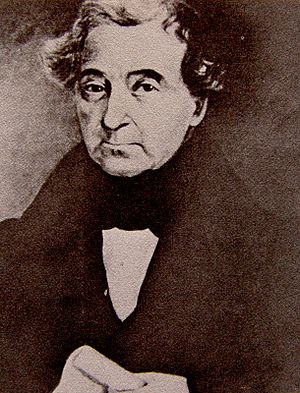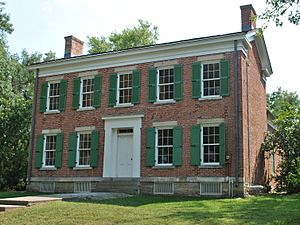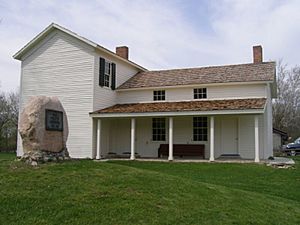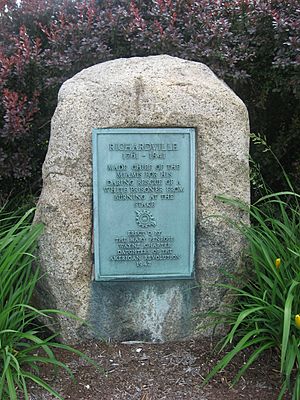Jean Baptiste Richardville facts for kids
Quick facts for kids
Jean Baptiste de Richardville (Pinšiwa or Peshewa in Miami-Illinois language)
|
|
|---|---|
 |
|
| Civil chief of the Miami people | |
| Personal details | |
| Born | ca. 1761 Kekionga (present-day Fort Wayne, Indiana, United States) |
| Died | August 13, 1841 Allen County, Indiana |
| Resting place | Fort Wayne, Allen County, Indiana |
| Parents | Tacumwah and Antoine-Joseph Drouet de Richerville |
Jean Baptiste de Richardville (born around 1761 – died August 13, 1841) was a very important leader of the Miami people. His Miami-Illinois names were Pinšiwa or Peshewa, which mean "Wildcat" or "Lynx". In English, he was also known as John Richardville. He was the last akima, or civil chief, of the Miami tribe.
Richardville started as a fur trader in the 1790s. He controlled a key portage (a place where boats or goods are carried overland between two waterways) in what is now Indiana. This portage connected the Maumee River to the Little River. He became a main chief in 1816 and led the Miamis until he died in 1841.
He signed many important agreements, called treaties, with the U.S. government. These included the Treaty of Greenville (1795) and others like the Treaty of Fort Wayne (1803) and the Treaty of the Wabash (1840).
Richardville and other Miami leaders were sometimes criticized for gaining wealth from these treaties. However, their efforts helped the Miami people stay in Indiana for many more years. They also got better deals for Miami lands. Thanks to these treaties, about half of the Miami people, including 43 members of Richardville's family, could stay in Indiana. The rest of the Miamis moved west in 1846. Richardville even let some Miamis stay on his own land. Those who stayed in Indiana became part of the Miami Nation of Indiana. Many of Richardville's family members still live in Indiana today.
For his role as a chief and negotiator, the U.S. government gave Richardville a lot of land in Indiana (about 28,320 acres) and cash payments ($31,800). In 1827, a two-story brick house was built for him in Fort Wayne, Indiana. The U.S. government helped pay for it. This house, known as Richardville House, is now a National Historic Landmark. Some people say Richardville was once the richest Native American in Indiana.
Contents
Early Life and Family Connections
Jean Baptiste de Richardville was born around 1761 in Kekionga, a Miami village. This place is now Fort Wayne, Indiana. He was métis, meaning he was half French and half Miami. His mother, Tacumwah, was an important Miami chieftess. His father, Antoine-Joseph Drouet de Richerville, was a French-Canadian fur trader.
Richardville spent some of his childhood in Quebec, Canada, with his father. He went to school there for a few years. In the late 1770s, he returned to Kekionga to live with his mother and the Miamis. He learned to speak Miami, French, and English very well. His mother ran a trading business, and he learned how to be a successful trader from her.
Because the Miami tribe had a matrilineal system, Richardville gained his leadership status through his mother's family. This meant he got authority from his mother’s brother, Chief Pacanne. Richardville became more involved in Miami affairs as an ally of his uncles, Chief Pacanne and Chief Little Turtle. After the War of 1812, he began to identify more with the Miami people. He became a very important leader. As an adult, he even stopped speaking English or French and wore Miami-style clothing.
Around 1800, Richardville married Natoequah, a Miami woman. They had at least six children: three sons (Joseph, John Baptist Jr., and Miaqueah) and three daughters (Maria Louise, Catherine, and Susan). His daughter Catherine married Francis La Fontaine, who became the Miami chief after Richardville died in 1841.
Fur Trade and Business Success
Richardville started his career as a successful trader at Kekionga. His mother also ran a trading post nearby. These two posts were important for trade between the Maumee River and the Wabash River, which connected the Great Lakes to the Mississippi River Valley. Richardville and his mother earned most of their money from the fur trade. They also charged fees for transporting goods over the portage connecting the Maumee River to the Little River.
Even though the U.S. Congress said all waterways and portages should be free to use, Richardville got a special license in 1815. This license gave him a monopoly (exclusive control) over the portage services. This made him a lot of money from trade. By 1824, he was wealthy enough to buy land in Fort Wayne for his home and trading post. In 1831, he moved the Miami tribal headquarters and his trading post closer to the Miami villages.
Leading the Miami People
From the late 1790s until his death in 1841, Richardville was a very important leader of the Miami people. He was involved in treaty negotiations with the U.S. government. He also helped decide how federal money and goods given to the Miamis would be used.
Historians note that Richardville and other Miami leaders, like Francis Godfroy, gained personally from their roles. However, they also worked hard to slow down discussions about giving up land and moving the Miamis from Indiana. These delays gave them more time to negotiate better deals and delay the removal of the Miami people to lands west of the Mississippi River.
Treaty of Greenville, 1795
After the Native American defeat at the Battle of Fallen Timbers in 1794, Richardville wanted a peaceful agreement. He was one of three Miami leaders who signed the Treaty of Greenville in 1795. This treaty set the boundaries for American Indian lands in the Northwest Territory. It also said that only the U.S. government could buy American Indian lands.
Treaties of Fort Wayne, 1803 and 1809
In the early 1800s, Richardville's influence grew because of his close connection with his uncle, Chief Little Turtle. To protect the Miami people, Richardville signed treaties with federal officials in 1802 and 1803. The Treaty of Fort Wayne (1803) gave a large piece of land in what is now southwest Indiana and parts of Illinois to the U.S. government. Most Miamis supported this because few of them lived on that land.
Richardville was also a leader in the 1809 treaty negotiations in Fort Wayne. Even though he first resisted giving up more Miami lands, the Treaty of Fort Wayne (1809) gave land along the Wabash River to the government. In return, it strengthened Miami control in areas of present-day northern Indiana.
Becoming the Principal Chief
After his uncle Chief Pacanne died in 1815, Richardville, at 55 years old, became the main chief of the Miamis. Francis Godfroy also became an important leader. Because both men had mixed heritage (French and Miami) and knew federal officials, they became key negotiators for the Miamis. They understood the value of land and trade in American society. They worked together to protect Miami interests and their own.
The value of Miami lands and the arrival of settlers in Indiana gave Richardville and other Miami leaders more power in land sales. Richardville was a smart negotiator. He got good deals for the Miami people and also increased his own wealth. He and other Miami leaders also delayed treaties that called for the Miamis to be removed from Indiana.
Treaty of St. Mary's, 1818
Richardville signed the Treaty of St. Mary's (1818). This treaty gave most of the Miami lands south of the Wabash River in central Indiana to the U.S. government. The Miamis received 6.4 cents per acre for their land. They also got an increase in their yearly payment to $18,400, plus other goods and services.
Richardville and other Miami leaders also made sure that a large area called the Miami National Reserve was not given away. This land was about 875,000 acres in central Indiana. It was very valuable for future development. The remaining Miami lands were divided into village reserves and individual land grants. Richardville, as the main Miami chief, received 5,760 acres for himself.
Treaty of Mississinewas, 1826
The Treaty of Mississinewas was signed in Indiana on October 23, 1826. Richardville and 36 other Miami representatives met with U.S. government officials. Under this treaty, the Miamis gave up claims to land north and west of the Wabash and Miami Rivers. However, they kept reserved lands at six village sites and other areas.
The federal government agreed to pay $600 to nine individuals, including Richardville, to help build their homes. Richardville also received individual land grants, which he could not sell without the U.S. president's approval. The treaty also set aside $2,000 each year to educate Miami children and care for the poor and sick.
Treaties of 1834, 1838, and 1840
Richardville did not want the Miamis to leave Indiana. But he realized that the time had come to get the best terms for their land and eventual removal. So, he signed treaties in 1834, 1838, and a final one in 1840. These treaties gave most of the Miami National Reserve land to the U.S. government.
In the 1834 treaty, Richardville received about 2,080 more acres of land. He and five other chiefs also got "fee simple titles" to their land. This meant they could sell their property without needing approval from the federal government.
In the 1838 treaty, Richardville received an additional 4,800 acres of land. Finally, in the Treaty of the Wabash (1840), the Miami people agreed to give up their remaining 500,000 acres in Indiana. In exchange, they received 500,000 acres in what is now Kansas. They also agreed to move from Indiana within five years. Under this treaty, Richardville received another 4,480 acres and $25,000 in cash. Importantly, the treaty allowed Richardville and others who had received individual land grants to stay in Indiana. This meant about half of the Miami people could remain.
Later Years and Legacy
Some historians say Richardville became "one of the richest men in the United States." At his death in 1841, he reportedly had about $200,000 in cash and owned thousands of acres of land in Indiana. He also owned his impressive brick home in Fort Wayne.
While Richardville received a lot of land, much of it eventually went to his associates. In his later years, he kept only a few hundred acres in Indiana, including his home in Fort Wayne. He often let family members and other Miamis stay on his private lands if they had nowhere else to live.
Richardville died on August 13, 1841, at his home near Fort Wayne. He was buried in the cemetery at the Cathedral of the Immaculate Conception in Fort Wayne. He left his property to his children and other relatives. His son-in-law, Francis La Fontaine, became the next chief of the Miamis.
About half of the Miami people, including Richardville's family, stayed in Indiana after the U.S. government officially moved the Miamis west in 1846. The treaties of 1838 and 1840 allowed 126 Miamis to remain in Indiana. These individuals, along with 22 others, formed the original 148 members of the Miami Nation of Indiana. While some of Richardville's descendants later moved to Kansas and Oklahoma, many more stayed in Indiana.
Richardville's life shows how mixed-heritage leaders in the Midwest dealt with changes after the War of 1812. He was well-educated and became a successful trader. As he gained influence, he became the main chief. As a treaty negotiator, he tried to protect the Miami people's interests when their political power was decreasing. While he personally benefited, he also worked to get good terms for the Miami people and fair prices for their lands. He and other Miami leaders successfully delayed the removal of the Miami people from Indiana until just before his death. He also provided a home for displaced Miamis on his land.
People have different opinions about Richardville's actions as a chief and negotiator. Some praised him as smart and careful. Others called him "artful and deceitful." However, many agree that he was a shrewd negotiator who looked out for his family and friends. Most importantly, he delayed the removal of the Miami people from Indiana for decades.
Richardville's Homes
Richardville owned several properties in Indiana. His most famous home was Richardville House, a brick house in Fort Wayne. He also had property at the Forks of the Wabash in Huntington County, Indiana.
Richardville House
Under the Treaty of Mississinewas (1826), the U.S. government gave Richardville and nine other chiefs $600 each to help build their homes. Richardville wanted a bigger, fancier two-story house, so he added $1,600 of his own money. The house cost about $2,200 in total.
When it was finished in 1827, Richardville House in Fort Wayne became the first known Greek Revival-style house in northeastern Indiana. It is also one of the few surviving "treaty houses" in the eastern United States that is still on its original site.
The house was Richardville's main home until he died in 1841. His family owned it until 1894. In 1991, the Allen County–Fort Wayne Historical Society bought the house and restored its outside. The society opens the house for visitors during the summer and offers programs about Miami history there. In 2012, the U.S. government named the home a National Historic Landmark.
Chief Richardville House and Miami Treaty Grounds
The Chief Richardville House and Miami Treaty Grounds are part of the Forks of the Wabash historic park. This park is along the Wabash River, about 2 miles west of Huntington. In 1831, Richardville moved the Miami council house (tribal headquarters) from Fort Wayne to the Miami reserve land at the Forks of the Wabash.
A treaty was signed at this site in 1838, as well as the Treaty of the Wabash (1840). There is some disagreement about whether the house at the Forks of the Wabash was built by Richardville or his son-in-law, Francis LaFontaine. Some believe the house was built in 1843–44, after Richardville's death. The house was later restored to look as it did in 1846. The property at the Forks of the Wabash was added to the National Register of Historic Places in 1985.
Honors and Tributes
- Richardville County, Indiana, was named after Chief Richardville. It was later renamed Howard County.
- Wildcat Creek (Indiana), a stream in Indiana, was named for Richardville.
- In 1966, the Indiana Sesquicentennial Commission put up a historical marker for Richardville at the Forks of the Wabash Historic Park.
- In 1992, the Indiana Historical Bureau put up another historical marker honoring Richardville near Peru.




